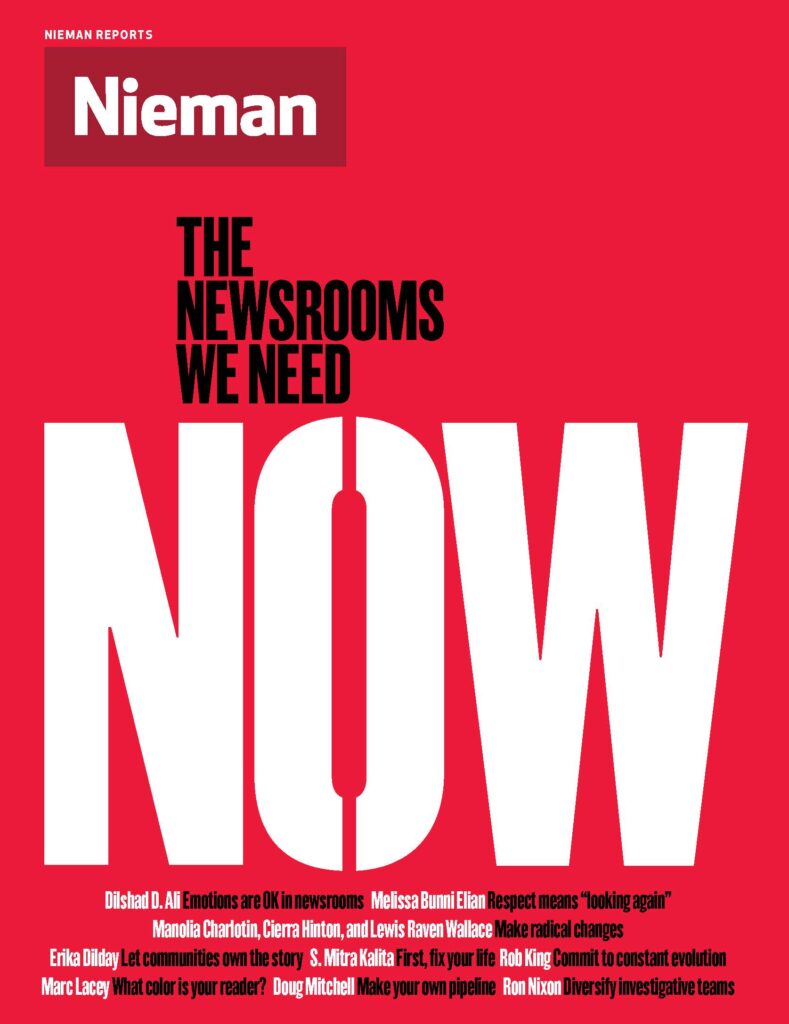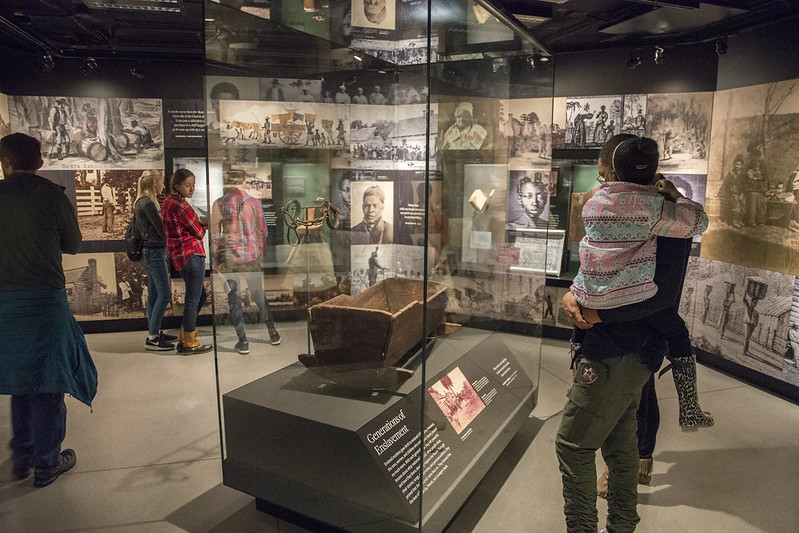
As American society grapples with growing demands for racial justice, American newsrooms are struggling with how to appropriately respond. Beyond making newsrooms more diverse, how should journalism meet the challenges of the moment and change newsroom structures and cultures that uphold oppression?
In a series of essays, thought leaders reflect and offer prescriptions for what the news industry needs to do.
If you are looking at this reckoning on race and trying to change your newsroom, I ask you to do something harder: Take a critical look at yourself.
There are no easy answers to solve for diversity, equity, and inclusion. It must become a way of life in order to become a way of work. Some actions you might consider…
- READ. Maybe you’ve read “White Fragility” but what about books that center Black voices and experiences? I am grateful I grew up in a home with something by James Baldwin in every room. Some other transformative works: “The Autobiography of Malcolm X.” “Native Son.” “Beloved.” “Song of Solomon.” “Their Eyes Were Watching God.” “Americanah.” “The Water Dancer.” “The Beautiful Struggle.” Go global, too: “Things Fall Apart.” “An Obedient Father.” “Dreaming in Cuban.” “One Hundred Years of Solitude.” “Purple Hibiscus.” “Brick Lane.” I’m reading “Caste” right now. Those bookshelves in your Zoom backdrop should overflow with literature that expands and challenges your world view.
- BUY BLACK DOLLS. I realized as I went around my house the other day that my kids have a lot of Black dolls. Many are gifts from friends and me; others are their own requests, applied to the world they create, the world they want, when they play house, school, doctor, princess, office. Weave Black toys, books, and dolls into your children’s lives or as gifts for others. Force an appreciation and accommodation of new perspectives at a young age.
- CURATE YOUR FEEDS. Join groups or follow people different from you (across the political spectrum, across geography, race, class, and language lines.). Do NOT label and box us off into some “diversity” list because we can see that on Twitter and it’s annoying.
- SWITCH UP YOUR VACATIONS. Learn history: All journalists should visit the Smithsonian National Museum of African American History & Culture, the Equal Justice Initiative’s Legacy Museum and National Memorial for Peace and Justice in Montgomery, Alabama, Martin Luther King’s boyhood home in Atlanta and Ebenezer Baptist Church. Ellis Island, Angel Island, the Lower East Side Tenement Museum. Olvera Street. So many Chinatowns. In order to tell our stories, you must learn our histories.
- ASSESS YOUR FRIENDSHIPS. Was your wedding invite list all White? Your dinner parties and other social gatherings? Do you know the names and life stories of the people around you, grocers to mail carriers? Do you help their kids land internships like you do your college buddy’s? If you do not embrace or operate in diverse circles, it will be very difficult to diversify your newsroom. If you have gone this long without legitimate relationships with people of color, know that it might be hard and the burden of building is on you. Join one of the affinity groups for journalists of color (or all of them). Attend networking events (not just the annual convention). If you want diversity to infuse your predominantly white institutions, think about meeting us halfway.
- ENGAGE. Did you choose to live in a town or neighborhood that is not diverse? Consider what and who you mean when you say things like “safe” or “quaint” or “good schools.” Call out racist comments when you hear them or even after the fact. Know that the price you pay for your relative comfort is to be uncomfortable. Work to level the playing field.
- LOVE. Look for the good in people who are different from you. See your children, mothers, friends, uncles in us. Think twice before speaking negatively about people of color. It is held against us in a way that is different from White colleagues, who get to have different career trajectories on the potential they represent versus the path of being twice as good. Shift your mind in how you see diverse talent and shift your bias so if you see Black and Latino names, you reach out and want to offer a leg up.
- DIVERSIFY YOUR NETWORKS. When you contract a lawyer or an accountant, hire a real estate agent or a financial planner, find a doctor or a therapist, see this as an opportunity to diversify the business of your life. Beware of referrals from friends saying “I know a guy…” when the guy always looks the same. Be intentional about shaking up your networks.
- REALIZE IT’S NOT ABOUT YOU. You must center Black voices even at your own expense. I advise my fellow Asians to advocate for those not at the table. Do not ask “what about us” and be so rooted in our own identity that you cannot recognize our relative privilege. This is only heightened for White colleagues. Some lines to avoid in memos and communication: “There’s a pipeline issue.” Or “We hired for diversity and thus had some performance issues” or “The best person should get the job” or “White guys have no chance right now.” Everyone gets to be okay if we get this right.
- BE NONTRANSACTIONAL. Consider holding at least three calls a week with random journalistic talent, mostly women or people of color. DO NOT interview them for jobs but simply try to soak up how they consume media, what they’re reading/thinking, what challenges they face, what brings them joy etc. This action forces us to get away from the transactional nature our industry usually has with diverse talent — “I have a job. We don’t want a White guy. We want you for your diversity. Please apply!” — and take a step back to forge more human, meaningful connections.
- THE RULE OF THREE. You know that old rule of journalism that says if three things are true, it’s a trend? Break that trend if it refers to three white people. Job candidates. Teams. Committees. Direct reports. People in the meeting. The bylines on the stories praised or mentioned. The folks assigned to the shiny new thing. Break the trend. Say and praise the names of non-White talent publicly. Check the room. Change the room. Who’s at the table? Add more voices of the missing perspectives.
- HIRE MORE BLACK PEOPLE. We know what we really need to do. Do not say “people of color” or “minorities” or BIPOC when you mean Black. Say Black. Black editors. Black reporters. Black designers. Black teachers. Black doctors. Black presidents. Black vice presidents. Black senior vice presidents. Black excellence. Asians like me might cloud the lack of Black staffers when we report diversity numbers. Let’s get honest and more exacting on this.
- ADD YOUR OWN ACTION. Don’t just ask people of color for their thoughts on diversity. I’ve given you a dozen of my ideas based on decades of doing the work. This is not a checklist or a bunch of merit badges you earn, rather a path to baseline competence. Good luck.
S. Mitra Kalita is the senior vice president for news, opinion, and programming for CNN Digital.
The Newsrooms We Need Now
As American society—and American newsrooms—grapple with an unprecedented time in the country’s racial justice movement, Nieman Reports is publishing a series of essays about how journalism should respond to the challenges of the moment, from accelerating journalists of color moving into senior decision-making roles to improving coverage of racism and white supremacy.



